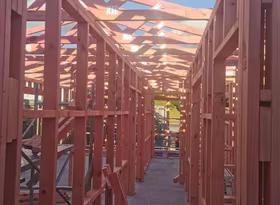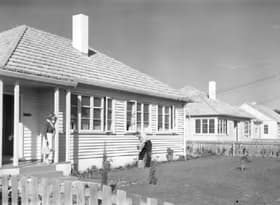
Being green and saving money
Many of us have come to accept that doing the right thing for the environment comes with a higher cost. Upgrading our homes to become more energy efficient or purchasing an EV to save emissions tends to come with a high upfront cost, and it can take many years to become better off. However, our recent analysis for the New Zealand Green Building Council (NZGBC) – and their sponsors Cotality, OneRoof and Squirrel – found that households can be substantially better off with the benefits of a greener home.
Kiwis concerned about cost, care about climate
A survey of attitudes to sustainability by Kantar found that 75% of New Zealanders were concerned about the cost of living, and 52% were concerned about the impact of climate change on New Zealand. This result indicates that reducing the impact of climate change is a key concern, but for is trumped by cost, especially in the current challenging economic environment. Homes account for about 10% of New Zealand’s greenhouse gas emissions, so making improvements in our homes could make a significant contribution to emission reductions.
Homestar sets a higher bar for homes
Homestar is a set of standards for higher performing homes run by the NZGBC. Differing levels – or stars – indicate a higher performance above building code minimum. 6 Homestar represents an affordable increment above building code minimum, which ensures a warmer, drier and healthier environment through higher insulation and ventilation standards. Homestar homes use less energy, no fossil fuels, and have a reduced risk of overheating.
Homestar doesn’t cost much more
Analysis by Aurecon found that building and certifying to 6 Homestar standard house costs 0.8% more than the Building Code minimum for standalone dwellings, and 0.7% for terraced dwellings, based on the average of building costs in Auckland, Wellington and Christchurch (see Chart 1).
In the past, Homestar carried a higher cost premium, as high as 4% in 2018. However, improvements to building code energy efficiency standards in 2021 raised the bar for standard homes, and conversely reduced the amount of extra work required to reach 6 Homestar.
Homestar saves on electricity
Dwellings built to 6 Homestar standard are estimated to use between 1,100 and 3,000 fewer kWh hours of electricity per year compared with a Building Code minimum dwelling. Chart 2 shows that households in a 6 Homestar terraced house could save $459 on electricity in 2025 compared to Building Code minimum, or $435 for a standalone house.
Savings range more widely depending on the type of house and where in the country it is, from $296 (for a standalone house in Auckland) to $760 (for a standalone house in Christchurch) in their first year. Factoring in electricity price rises, the electricity savings from a Homestar home could total between $580 and $1,500 per year by 2050.
Homestar qualifies for a cheaper mortgage
Since 2019, ANZ has offered Healthy Home Loans with discounted mortgage rates for homes with a 6 Homestar or higher rating. These discounts amount to a 0.25% discount off widely available mortgage rates, and apply to the entire mortgage balance. Our analysis assumes that ANZ’s Healthy Homes offer continues to be made available throughout the life of the loan. There is currently no stated expiry for the offer.
Households save $6,800 interest in first 5 years
Owners of a 6 Homestar dwelling with an ANZ mortgage could save at least $6,800 on interest payments in the first five years of their mortgage, with the effect of lower interest rates across their whole mortgage outweighing the slightly higher construction cost upfront. Chart 3 shows that mortgage interest savings range from $6,800 for a terraced house in Wellington or Christchurch to $13,700 for a standalone house in Auckland.
Savings stack up to over $60k in 30 years
Over a 30-year period, households buying a Homestar house would save at least $62,000 on electricity and interest payments. Chart 4 shows that electricity and interest savings combined range from $62,800 for a terraced house in Auckland up to $98,800 for a standalone house in Wellington.
Households better off in 2-3 years
Households would be better off within 2-3 years, despite a slightly higher upfront cost for 6 Homestar. Savings stemming from lower interest rates and lower electricity usage outweigh the cost of 6 Homestar, including the cost of borrowing to fund 6 Homestar. Chart 5 shows that the cumulative savings from a 6 Homestar house would exceed the cost in year 3. By year 30, the savings of $95,400 would dwarf costs of $28,900, meaning that households would be better off by $66,500. Households would have to borrow to fund the upfront cost of Homestar, so the costs stated here include annual interest on the upfront cost.
Homestar pays off even earlier for households buying a terraced house, with savings expected to outweigh the cost of construction by year two. By year 30, the household would be better off by $50,100.
Strong incentives for landlords and developers too
Beyond benefits for owner-occupiers, the Homestar scheme can be advantageous for developers and landlords. BNZ, Westpac, ASB and Kiwibank offer discounted development finance for certified Homestar developments, which serves as an incentive to increase the supply of Homestar houses. Landlords are eligible for ANZ’s Healthy Home Loan scheme too and would benefit from the discounted interest rate, as interest savings make up the majority of Homestar savings. The attributes of reduced electricity consumption and better indoor air quality might help to attract tenants, and potentially even earn higher rents, as general awareness of Homestar increases.
On the up
Homestar certified homes made up 13% of new dwellings consented in New Zealand in 2020, with only ANZ supporting homeowners with a mortgage discount. As more Kiwis become aware that they can have their sustainability cake and eat it too, we might expect uptake to rise, and especially so if more banks come to the party.
For more information, see our full report or get in touch.
















